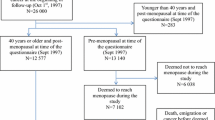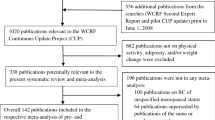Abstract
Purpose
The associations between anthropometric factors, physical activity (PA), and breast cancer risk in terms of estrogen-receptor/progesterone-receptor (ER/PgR) status have been unclear in Japanese women. This case–control study was designed to evaluate these associations.
Methods
From among female patients aged 30 years and over admitted to a single hospital in Japan between 1997 and 2009, 1,017 breast cancer cases (538ER+/PgR+, 125ER+/PgR−, 23 ER−/PgR+, 249 ER−/PgR−, and 82 missing) and 2,902 controls were selected. Height, weight, body mass index (BMI) (kg/m2), and time spent exercising (hours/week) were assessed using a self-administered questionnaire. Polytomous logistic regression analysis and tests for heterogeneity across ER+/PgR+ and ER−/PgR− were conducted.
Results
Higher BMI was associated with a higher risk of ER+/PgR+ cancer among women overall [odds ratio (OR) = 2.41, 95 % confidence interval (CI) 1.37–4.23 for BMI ≥30.0; P trend = 0.0001] and postmenopausal women (OR = 6.24, 95 % CI 2.68–14.53 for BMI ≥30.0; P trend < 0.0001). A longer time spent exercising (more than 5 h/week) showed a decreased risk for any type of breast cancer among overall and pre- and postmenopausal women, although this did not reach statistical significance. Height was not associated with any risk.
Conclusions
Higher BMI is associated with an increased risk of ER+/PgR+ cancer among women overall and postmenopausal women. PA might be associated with a decreased risk of any type. To prevent breast cancer, weight control and PA are important.
Similar content being viewed by others
References
American Institute for Cancer Research., World Cancer Research Fund (2007) Food, nutrition, physical activity and the prevention of cancer: a global perspective: a project of World Cancer Research Fund International. American Institute for Cancer Research, Washington, DC
van den Brandt PA, Spiegelman D, Yaun SS et al (2000) Pooled analysis of prospective cohort studies on height, weight, and breast cancer risk. Am J Epidemiol 152:514–527
Ursin G, Longnecker MP, Haile RW, Greenland S (1995) A meta-analysis of body mass index and risk of premenopausal breast cancer. Epidemiology 6:137–141
Renehan AG, Tyson M, Egger M, Heller RF, Zwahlen M (2008) Body-mass index and incidence of cancer: a systematic review and meta-analysis of prospective observational studies. Lancet 371:569–578
Monninkhof EM, Elias SG, Vlems FA et al (2007) Physical activity and breast cancer: a systematic review. Epidemiology 18:137–157
Goodman MT, Cologne JB, Moriwaki H, Vaeth M, Mabuchi K (1997) Risk factors for primary breast cancer in Japan: 8-year follow-up of atomic bomb survivors. Prev Med 26:144–153
Kawai M, Minami Y, Kuriyama S et al (2010) Adiposity, adult weight change and breast cancer risk in postmenopausal Japanese women: the Miyagi Cohort Study. Br J Cancer 103:1443–1447
Kuriyama S, Tsubono Y, Hozawa A et al (2005) Obesity and risk of cancer in Japan. Int J Cancer 113:148–157
Ueji M, Ueno E, Osei-Hyiaman D, Takahashi H, Kano K (1998) Physical activity and the risk of breast cancer: a case-control study of Japanese women. J Epidemiol 8:116–122
Sorlie T, Tibshirani R, Parker J et al (2003) Repeated observation of breast tumor subtypes in independent gene expression data sets. Proc Natl Acad Sci USA 100:8418–8423
Yamashita H, Iwase H, Toyama T et al (2011) Estrogen receptor-positive breast cancer in Japanese women: trends in incidence, characteristics, and prognosis. Ann Oncol 22:1318–1325
Rakha EA, El-Sayed ME, Green AR et al (2007) Biologic and clinical characteristics of breast cancer with single hormone receptor positive phenotype. J Clin Oncol 25:4772–4778
Peters TM, Schatzkin A, Gierach GL et al (2009) Physical activity and postmenopausal breast cancer risk in the NIH-AARP diet and health study. Cancer Epidemiol Biomarkers Prev 18:289–296
Dallal CM, Sullivan-Halley J, Ross RK et al (2007) Long-term recreational physical activity and risk of invasive and in situ breast cancer: the California teachers study. Arch Intern Med 167:408–415
McTiernan A, Kooperberg C, White E et al (2003) Recreational physical activity and the risk of breast cancer in postmenopausal women: the Women’s Health Initiative Cohort Study. JAMA 290:1331–1336
Canchola AJ, Anton-Culver H, Bernstein L et al (2012) Body size and the risk of postmenopausal breast cancer subtypes in the California Teachers Study cohort. Cancer Causes Control 23:473–485
Rosenberg LU, Einarsdottir K, Friman EI et al (2006) Risk factors for hormone receptor-defined breast cancer in postmenopausal women. Cancer Epidemiol Biomarkers Prev 15:2482–2488
John EM, Sangaramoorthy M, Phipps AI, Koo J, Horn-Ross PL (2011) Adult body size, hormone receptor status, and premenopausal breast cancer risk in a multiethnic population: the San Francisco Bay Area breast cancer study. Am J Epidemiol 173:201–216
Ahn J, Schatzkin A, Lacey JV Jr et al (2007) Adiposity, adult weight change, and postmenopausal breast cancer risk. Arch Intern Med 167:2091–2102
Suzuki R, Orsini N, Saji S, Key TJ, Wolk A (2009) Body weight and incidence of breast cancer defined by estrogen and progesterone receptor status–a meta-analysis. Int J Cancer 124:698–712
Enger SM, Ross RK, Paganini-Hill A, Carpenter CL, Bernstein L (2000) Body size, physical activity, and breast cancer hormone receptor status: results from two case-control studies. Cancer Epidemiol Biomarkers Prev 9:681–687
Cotterchio M, Kreiger N, Theis B, Sloan M, Bahl S (2003) Hormonal factors and the risk of breast cancer according to estrogen- and progesterone-receptor subgroup. Cancer Epidemiol Biomarkers Prev 12:1053–1060
Althuis MD, Fergenbaum JH, Garcia-Closas M, Brinton LA, Madigan MP, Sherman ME (2004) Etiology of hormone receptor-defined breast cancer: a systematic review of the literature. Cancer Epidemiol Biomarkers Prev 13:1558–1568
Adams SA, Matthews CE, Hebert JR et al (2006) Association of physical activity with hormone receptor status: the Shanghai Breast Cancer Study. Cancer Epidemiol Biomarkers Prev 15:1170–1178
Ritte R, Lukanova A, Berrino F et al (2012) Adiposity, hormone replacement therapy use and breast cancer risk by age and hormone receptor status: a large prospective cohort study. Breast Cancer Res 14:R76
Suzuki R, Rylander-Rudqvist T, Ye W, Saji S, Wolk A (2006) Body weight and postmenopausal breast cancer risk defined by estrogen and progesterone receptor status among Swedish women: a prospective cohort study. Int J Cancer 119:1683–1689
Steindorf K, Ritte R, Eomois PP et al (2013) Physical activity and risk of breast cancer overall and by hormone receptor status: The European prospective investigation into cancer and nutrition. Int J Cancer 132:1667–1678
Iwasaki M, Otani T, Inoue M, Sasazuki S, Tsugane S (2007) Body size and risk for breast cancer in relation to estrogen and progesterone receptor status in Japan. Ann Epidemiol 17:304–312
Yoo K, Tajima K, Park S et al (2001) Postmenopausal obesity as a breast cancer risk factor according to estrogen and progesterone receptor status (Japan). Cancer Lett 167:57–63
Suzuki R, Iwasaki M, Yamamoto S et al (2011) Leisure-time physical activity and breast cancer risk defined by estrogen and progesterone receptor status—the Japan Public Health Center-based Prospective Study. Prev Med 52:227–233
Suzuki R, Iwasaki M, Kasuga Y et al (2010) Leisure-time physical activity and breast cancer risk by hormone receptor status: effective life periods and exercise intensity. Cancer Causes Control 21:1787–1798
Minami Y, Nishino Y, Kawai M, Kakugawa Y (2012) Being breastfed in infancy and adult breast cancer risk among Japanese women. Cancer Causes Control 23:389–398
Minami Y, Tateno H (2003) Associations between cigarette smoking and the risk of four leading cancers in Miyagi Prefecture, Japan: a multi-site case-control study. Cancer Sci 94:540–547
Minami Y, Tochigi T, Kawamura S et al (2008) Height, urban-born and prostate cancer risk in Japanese men. Jpn J Clin Oncol 38:205–213
Kawai M, Minami Y, Nishino Y, Fukamachi K, Ohuchi N, Kakugawa Y (2012) Body mass index and survival after breast cancer diagnosis in Japanese women. BMC Cancer 12:149
Kawai M, Kakugawa Y, Nishino Y, Hamanaka Y, Ohuchi N, Minami Y (2012) Reproductive factors and breast cancer risk in relation to hormone receptor and menopausal status in Japanese women. Cancer Sci 103:1861–1870
(1995) Physical status: the use and interpretation of anthropometry. Report of a WHO Expert Committee. World Health Organ Tech Rep Ser 854:1–452
Kakugawa Y, Minami Y, Tateno H, Inoue H, Fujiya T (2007) Relation of serum levels of estrogen and dehydroepiandrosterone sulfate to hormone receptor status among postmenopausal women with breast cancer. Breast Cancer 14:269–276
Juul A, Bang P, Hertel NT et al (1994) Serum insulin-like growth factor-I in 1030 healthy children, adolescents, and adults: relation to age, sex, stage of puberty, testicular size, and body mass index. J Clin Endocrinol Metab 78:744–752
Regensteiner JG, Mayer EJ, Shetterly SM et al (1991) Relationship between habitual physical activity and insulin levels among nondiabetic men and women. San Luis Valley Diabetes Study. Diabetes Care 14:1066–1074
OECD (2009) “Height”, in OECD, society at a glance 2009: OECD social indicators. c2001–2007. OECD Publishing, Paris
Sherman BM, Korenman SG (1974) Measurement of serum LH, FSH, estradiol and progesterone in disorders of the human menstrual cycle: the inadequate luteal phase. J Clin Endocrinol Metab 39:145–149
Walker K, Bratton DJ, Frost C (2011) Premenopausal endogenous oestrogen levels and breast cancer risk: a meta-analysis. Br J Cancer 105:1451–1457
Vainio H, Bianchini F (2002) Weight control and physical activity. IARC Press, Lyon
OECD. Overweight and obese population. OECD Publishing, Paris
Ministry of Health, Labour and Welfare (2008) National health and nutrition survey. Tokyo
Nestler JE, Powers LP, Matt DW et al (1991) A direct effect of hyperinsulinemia on serum sex hormone-binding globulin levels in obese women with the polycystic ovary syndrome. J Clin Endocrinol Metab 72:83–89
Gammon MD, John EM, Britton JA (1998) Recreational and occupational physical activities and risk of breast cancer. J Natl Cancer Inst 90:100–117
Fukao A, Tsubono Y, Komatsu S et al (1995) A cohort study on the relation of lifestyle, personality and biologic markers to cancer in Miyagi, Japan: study design, response rate and profiles of the cohort subjects. J Epidemiol 5:153–157
Nomura Y, Miura S, Koyama H et al (1992) Relative effect of steroid hormone receptors on the prognosis of patients with operable breast cancer. A univariate and multivariate analysis of 3089 Japanese patients with breast cancer from the Study Group for the Japanese Breast Cancer Society on Hormone Receptors and Prognosis in Breast Cancer. Cancer 69:153–164
Kawai M, Minami Y, Kakizaki M et al (2011) Alcohol consumption and breast cancer risk in Japanese women: the Miyagi Cohort study. Breast Cancer Res Treat 128:817–825
Kawai M, Minami Y, Kuriyama S et al (2010) Reproductive factors, exogenous female hormone use and breast cancer risk in Japanese: the Miyagi Cohort Study. Cancer Causes Control 21:135–145
Acknowledgments
This work was supported by JSPS KAKENHI Grant Number 23390169.
Conflict of interest
The authors declare that they have no conflict of interest.
Author information
Authors and Affiliations
Corresponding author
Rights and permissions
About this article
Cite this article
Kawai, M., Kakugawa, Y., Nishino, Y. et al. Anthropometric factors, physical activity, and breast cancer risk in relation to hormone receptor and menopausal status in Japanese women: a case–control study. Cancer Causes Control 24, 1033–1044 (2013). https://doi.org/10.1007/s10552-013-0181-5
Received:
Accepted:
Published:
Issue Date:
DOI: https://doi.org/10.1007/s10552-013-0181-5




